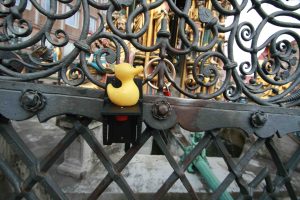
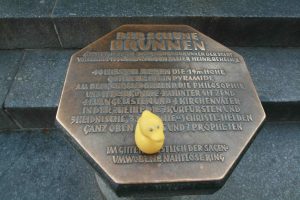
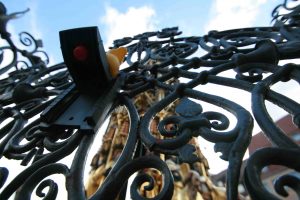
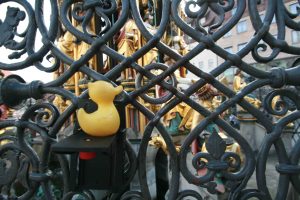
Luck Duck Sheila had to visit another Luck Symbol in Nürnberg Germany. At the “Hauptmarkt” (main market) in “Nürnberg” (Nuremberg) there is a nice fountain (19 m high) called “Schöner Brunnen” (nice fountain). The original in gothic stile was finished 1396 and the rests are in a museum now. It was new built 1903. The fountain is surrounded by an ingenious iron railing. Inserted in that railing are two seamless rings and it means good luck to turn those rings. Since Sheila is about 8 cm big I guess the rings are about 6,5 cm in diameter. It’s said that the first ring was inserted by a journeyman who had his eyes on his master’s daughter and she loved him too but the master didn’t allow a wedding. While the master and his daughter went on a trip the journeyman fixed the ring and inserted it in the railing, seamless. After that he left Nürnberg sad and lonly. After the master returned and saw the ring he was impressed and changed his mind but it was too late, the journeyman was gone and the daugther cried a lot. And since there was no phone or google he could not find him. Sorry, no happy end here. Now there are two rings in the railing (in a height of about 2,3 m), one of them in brass and the tourists turn it for good luck or to make a wish. The locals however turn the iron one instead as they consider it to be the true luck ring. So Luck Duck Sheila turned them both just to be on the save side.
The fountain is next to the City Hall were weddings are taking place in the registry office and it’s a custom that the fresh bewedded go to the ring to turn it.
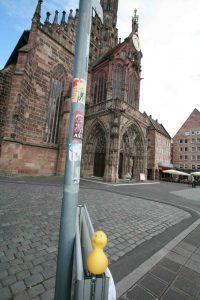
Sheila_Nürnberg_5 Sheila in front of the “Frauenkirche” (1358) “Stadtpfarrkirche unserer Lieben Frau” on the other side of the “Hauptmarkt”. Some say the fountain “Schöner Brunnen” was to become the peak of the church but since the fountain is several decades younger it’s unlikely. There are also chimes with moving (male) figures on the market (“Männleinlaufen”) which play at noon. The 7 male figures (3 bishops and 4 secular rulers) who circle round King Karl IV (who had his Residenz in Prag) represent the “Electors”, rulers who where entitled to elect the German King who usually also became german emperor if the Pope agreed. The election process was agreed on in 1356 which was like a constitution until the end of the First German Empire until 1806. The negotiations for that procedure startet 1338 at the “Kurverein von Rhense at the Rhine river close to Koblenz. The famous agreement is known as the “Goldene Bulle” (Golden Bull). The church was build on the site of a former Jewish Synagoge which was destroyed 1349 after Karl IV who called himselve Protector of the Jewish community (while charging the Jews in the empire taxes) received generous presents from the Nuremberg citizens who wanted to create a knew representative place in the city’s center. Karl IV after receiving the presents showed, that he would not mind offending his “Protection” which led to mass murder of the Jewish people also in Nuremberg at that time. It was also the time of a Black Plague all over the empire and the Jews where blamed for that without reason. On the plea of the Jews being responsible for the Black Plague or other made up reproaches the Jewish community was murdered and the Synagoge turned down as well as many houses of the Jews in the neighbourhood. And the bonds they owned were destroyed as well. Today after the reconstruction of the church after World War II a Star of David in the church reminds of those incidents.
![]()